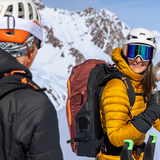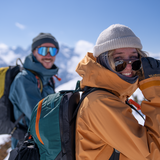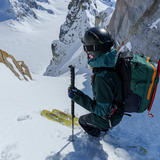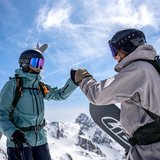Alproof SERIES

Alproof SERIES
For anyone looking for a ski touring backpack with the very best airbag technology and flexible gear packing options for ski traverses and extended ski tours.

For freeride skiers who want a lightweight, technical avalanche backpack that’s built for the rigors of backcountry skiing.

For ski touring fans who expect as much from their safety equipment as they do from their own performance.

For freeriders and freestylers who want maximum agility and full load control for their backcountry exploits — and refuse to compromise on style.

Your White Risk subscription for free
LEARN, TEST YOUR KNOWLEDGE AND PLAN AHEAD!
With every order of an Alproof avalanche backpack you get a half-year standard subscription of White Risk for free!

The clever tour planning app helps you minimize the risks in the backcountry together with your new deuter Alproof. Just create an account at whiterisk.ch and redeem the code you get in your deuter package in your White Risk account under Coupon.
Adjusting your avalanche backpack
The ALPRIDE E2 electronic avalanche air bag system
the lightest avalanche airbag system of its kind!
It’s also the first avalanche airbag system to use supercapacitors to drive an electric compressor, which then inflates the 162-liter airbag in just three seconds. Supercapacitors have distinct advantages compared to batteries and rechargeable batteries: They can generate a lot of power in a short space of time, without shortening their service life. They can store electricity without the use of chemical reactions, which is why they are unaffected by the cold. Their performance is the same, from -30° C to +50° C. Whereas rechargeable batteries such as lithium-ion lose power after multiple charges, supercapacitors maintain their performance. They can be charged 500,000 times and have a virtually endless lifespan. Supercapacitors are also lighter than regular batteries.

The top priority: avoiding avalanche
Why do you need an airbag?
Avalanches always pose a big risk, no matter what safety gear you have. Even with an airbag backpack, there are still situations where chances of survival are slim. Which is why having an airbag backpack does not mean you can take greater risks. The most important thing is to minimize the risk of an avalanche. This equates to thorough avalanche training, careful route planning, regular avalanche training refreshers, the courage to express your concerns to the group you’re with and being prepared to turn back. But even then, it’s still risky. This is where avalanche safety equipment and an airbag backpack can help reduce the rate of fatality.
Air bag effect
Remaining on the surface of an avalanche increases the chance of survival
Full burial is when the head and upper body are covered by snow from an avalanche. Partial burial is when the head and upper body remain free. With a full burial, the chance of death is 50%, whereas with a partial burial it is 4% (Brugger et al. 2001; Statistical analysis of avalanche fatalities, Europe and North America 1981-1998). There is therefore a greater chance of survival if you can avoid full burial in an avalanche situation. The Alpride air bag makes use of granular convection (or the Brazil nut effect), whereby larger particles end up on the surface of a granular material containing a mixture of variously sized objects, while smaller particles sink. The large surface area and rounded shape of the Alpride air bag make it buoyant in an avalanche. The shape of the air bag also protects the user’s back and head, and the luminous color makes it more noticeable during a search operation, where every second counts.


Charging the Alpride E2 System
The supercapacitors can be charged in two ways:
- via USB-C cable (5V–3A)
- with two AA batteries.
The system should primarily be charged via USB and only charged by batteries as a backup, e.g. when traveling. Charging can be done using the USB-C cable supplied and a regular USB charger (not supplied) or power bank, solar unit etc. Depending on the kind of charging device used, charging will take between 20 and 40 minutes. Charging via the USB cable is also possible without any batteries in place. When the batteries are inserted and
the cable is connected, charging will begin without draining the batteries.
Lithium AA batteries make the Alpride E2 system ready to deploy again, after an accidental deployment. They have enough power to generate 3 full system charges. It is advisable to replace these batteries after this – and after any deployment. As soon as the air bag is filled, the two AA batteries (if installed) will immediately recharge the supercapacitors.
Alpride E2 System runtime
We recommend that during a tour, two Lithium AA batteries are used, which have not been previously used to charge the system. These will make up for the small loss in charge of the supercapacitors. By doing so, the Alpride E2 system can be used for three months in between charges. If the Alproof is not going to be used for a longer period, the batteries should be removed. If the system is used after charging, but without batteries installed, the maximum runtime is 12 to 24 hours.


Pull the switch outward, turn it clockwise and hold it in the ‘ON’ position for two seconds.
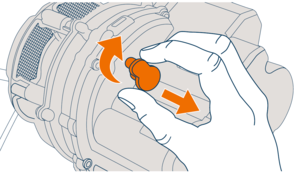
The Alpride E2 system carries out an ‘auto test’ every time it is switched on, to check the motor, supercapacitors and electronics are all fully operational. During this testing period, the three LED lights will light up one after the other to test they are working. Once the auto test is successfully completed, the system is ready to use. The motor will rev a second time and the green or orange LED light will flash depending on the charging status.
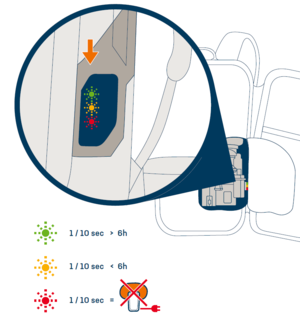

To deploy the air bag, the trigger handle must be tugged (5-10 kg force). The air bag will then be inflated at high pressure by the compressor motor, within three to five seconds. Once fully inflated, the supercapacitors will automatically be recharged by the two AA batteries (if inserted). The compressor is active for six seconds before switching itself off.
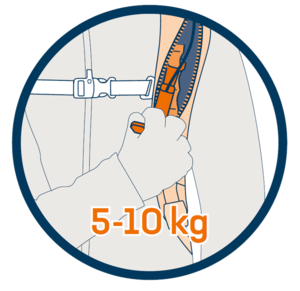

To deflate the air bag, open the safety cover on the release valve and press the orange button.
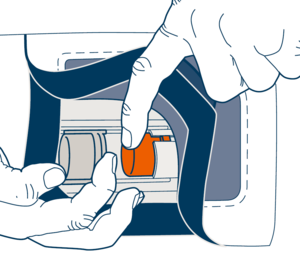
Once the air bag is empty the safety cover will spring back into place automatically. When packing away the air bag it is important to follow the correct procedure. Packing it away incorrectly could prevent the air bag from deploying, might cause it to malfunction and could damage the avalanche backpack. Do not twist the airbag, do not cross over any hooks, do not roll it up and do not obstruct the airbag compartment in any way.
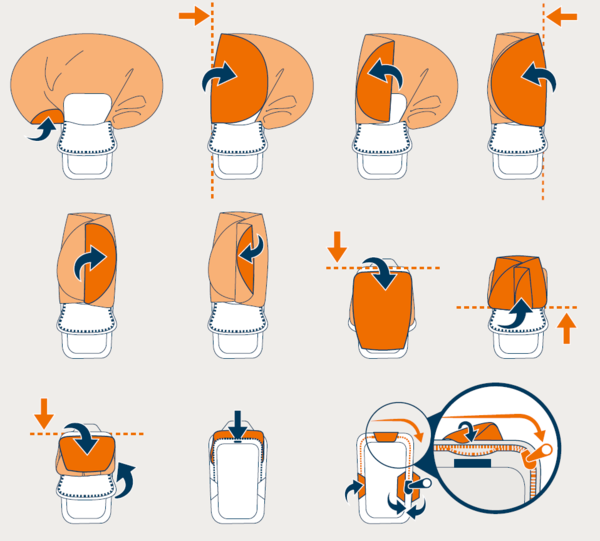
ALPROOF & E2 AIRBAG SYSTEM USER MANUAL
You can download the user manual for our airbag system backpacks Alproof and Alproof Lite here as a PDF.
FREQUENTLY ASKED QUESTIONS
Yes, in the Alproof 30 SL and 32 models the trigger handle can easily mounted on either side of the backpack.
The trigger handle should ideally be at chest height for the best accessibility. There are three heights it can be adjusted to. Simply rotate the trigger handle upwards and out of the loop on the shoulder strap, then reinsert it into the correct one.
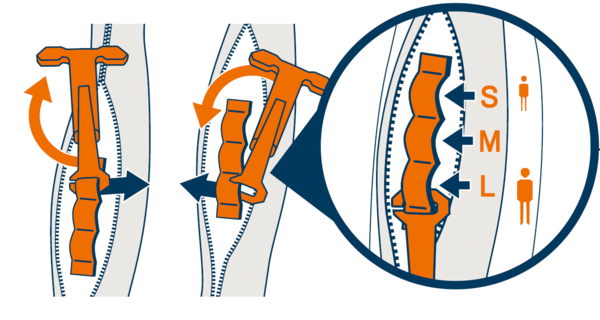
The waist belt, leg loop and sternum strap should all be tight and secure to create a snug fit. The leg loop is also there to prevent the backpack from being pulled over the skier’s head in an avalanche. The leg strap is easily secured without having to undo the waist belt.
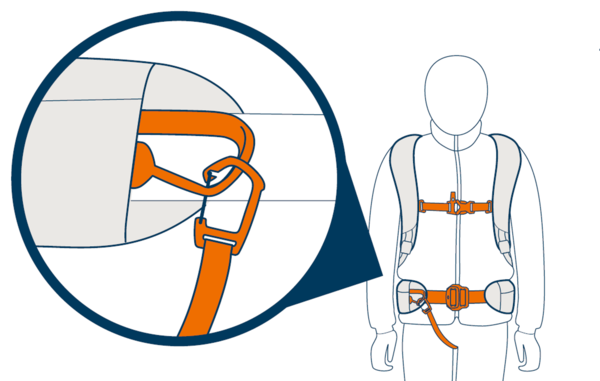
Generally, yes. The most important thing is for it to be deployed immediately and decisively. Accident data analysis* shows that as many as 12% of victims had not deployed the air bag. No correlation could be found between the size of the avalanche and the inability to deploy the air bag. But there was a significantly lower rate among professional users (mountain guides, ski patrollers) than hobby skiers (5% compared to 12%). Practice seems to be a deciding factor here. It’s therefore important to regularly practice deploying an air bag to train reactions and motor skills.
 81 % correctly inflated
81 % correctly inflated
12 % not deployed
3 % equipment failure
2 % maintenance error
2 % mechanical damage
*Source: Hägeli, Bergundsteigen Magazine 3/14; Statistical analysis of avalanche incident reports (1994 to 2012) in North America and various European countries; only avalanches that posed serious burial potential and involved persons with and without airbag backpacks were included.
And if in doubt, it’s better to deploy the air bag too many times, than not deploy it at all. This is easy to do with the Alpride E2 system since it can be deployed multiple times.
Simple: Both. Because with an avalanche air bag you can’t locate victims, and with an avalanche beacon you can’t prevent full burial. So the ideal avalanche safety equipment includes an avalanche air bag like the Alproof, an avalanche beacon, a shovel and a probe.
Yes. In the Alproof 30 SL and 32 models, skis can be attached diagonally across the front of the pack and at the sides in an A-frame, using the two modular gear straps.

